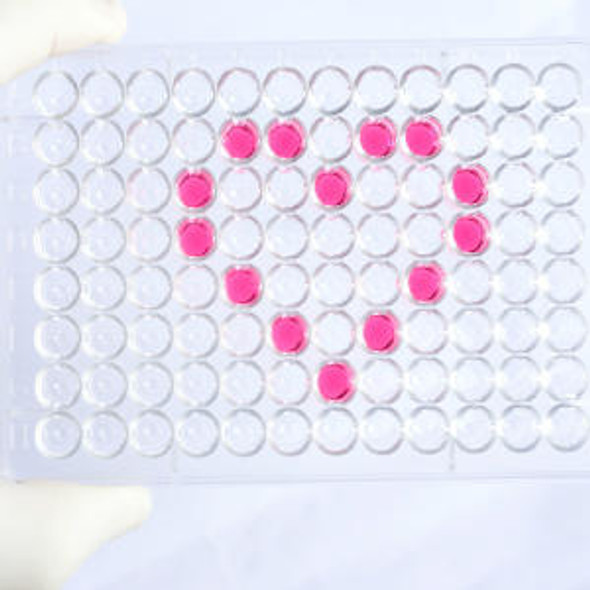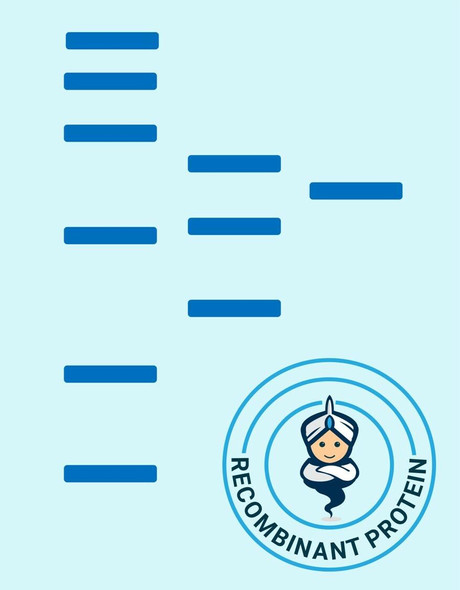Cell Biology Antibodies 12
Anti-Noggin Antibody (CAB8305)
- SKU:
- CAB8305
- Product Type:
- Antibody
- Applications:
- WB
- Reactivity:
- Mouse
- Reactivity:
- Rat
- Host Species:
- Rabbit
- Isotype:
- IgG
- Research Area:
- Cell Biology
Description
| Antibody Name: | NOG Rabbit Polyclonal Antibody |
| Antibody SKU: | CAB8305 |
| Antibody Size: | 20uL, 50uL, 100uL |
| Application: | WB |
| Reactivity: | Mouse, Rat |
| Host Species: | Rabbit |
| Immunogen: | Recombinant fusion protein containing a sequence corresponding to amino acids 28-232 of human NOG (NP_005441.1). |
| Application: | WB |
| Recommended Dilution: | WB 1:500 - 1:2000 |
| Reactivity: | Mouse, Rat |
| Positive Samples: | Mouse brain, Mouse spinal cord |
| Immunogen: | Recombinant fusion protein containing a sequence corresponding to amino acids 28-232 of human NOG (NP_005441.1). |
| Purification Method: | Affinity purification |
| Storage Buffer: | Store at -20'C. Avoid freeze / thaw cycles. Buffer: PBS with 0.02% sodium azide, 50% glycerol, pH7.3. |
| Isotype: | IgG |
| Sequence: | QHYL HIRP APSD NLPL VDLI EHPD PIFD PKEK DLNE TLLR SLLG GHYD PGFM ATSP PEDR PGGG GGAA GGAE DLAE LDQL LRQR PSGA MPSE IKGL EFSE GLAQ GKKQ RLSK KLRR KLQM WLWS QTFC PVLY AWND LGSR FWPR YVKV GSCF SKRS CSVP EGMV CKPS KSVH LTVL RWRC QRRG GQRC GWIP IQYP IISE CKCS C |
| Gene ID: | 9241 |
| Uniprot: | Q13253 |
| Cellular Location: | Secreted |
| Calculated MW: | 25kDa |
| Observed MW: | 28kDa |
| Synonyms: | NOG, SYM1, SYNS1, SYNS1A, noggin |
| Background: | The secreted polypeptide, encoded by this gene, binds and inactivates members of the transforming growth factor-beta (TGF-beta) superfamily signaling proteins, such as bone morphogenetic protein-4 (BMP4). By diffusing through extracellular matrices more efficiently than members of the TGF-beta superfamily, this protein may have a principal role in creating morphogenic gradients. The protein appears to have pleiotropic effect, both early in development as well as in later stages. It was originally isolated from Xenopus based on its ability to restore normal dorsal-ventral body axis in embryos that had been artificially ventralized by UV treatment. The results of the mouse knockout of the ortholog suggest that it is involved in numerous developmental processes, such as neural tube fusion and joint formation. Recently, several dominant human NOG mutations in unrelated families with proximal symphalangism (SYM1) and multiple synostoses syndrome (SYNS1) were identified; both SYM1 and SYNS1 have multiple joint fusion as their principal feature, and map to the same region (17q22) as this gene. All of these mutations altered evolutionarily conserved amino acid residues. The amino acid sequence of this human gene is highly homologous to that of Xenopus, rat and mouse. |
| UniProt Protein Function: | NOG: Essential for cartilage morphogenesis and joint formation. Inhibitor of bone morphogenetic proteins (BMP) signaling which is required for growth and patterning of the neural tube and somite. Defects in NOG are a cause of symphalangism proximal syndrome (SYM1). SYM1 is characterized by the hereditary absence of the proximal interphalangeal (PIP) joints (Cushing symphalangism). Severity of PIP joint involvement diminishes towards the radial side. Distal interphalangeal joints are less frequently involved and metacarpophalangeal joints are rarely affected whereas carpal bone malformation and fusion are common. In the lower extremities, tarsal bone coalition is common. Conducive hearing loss is seen and is due to fusion of the stapes to the petrous part of the temporal bone. Defects in NOG are the cause of multiple synostoses syndrome type 1 (SYNS1); also known as synostoses, multiple, with brachydactyly/symphalangism-brachydactyly syndrome. SYNS1 is characterized by tubular-shaped (hemicylindrical) nose with lack of alar flare, otosclerotic deafness, and multiple progressive joint fusions commencing in the hand. The joint fusions are progressive, commencing in the fifth proximal interphalangeal joint in early childhood (or at birth in some individuals) and progressing in an ulnar-to-radial and proximal- to-distal direction. With increasing age, ankylosis of other joints, including the cervical vertebrae, hips, and humeroradial joints, develop. Defects in NOG are the cause of tarsal-carpal coalition syndrome (TCC). TCC is an autosomal dominant disorder characterized by fusion of the carpals, tarsals and phalanges, short first metacarpals causing brachydactyly, and humeroradial fusion. TCC is allelic to SYM1, and different mutations in NOG can result in either TCC or SYM1 in different families. Defects in NOG are a cause of stapes ankylosis with broad thumb and toes (SABTS); also known as Teunissen- Cremers syndrome. SABTS is a congenital autosomal dominant disorder that includes hyperopia, a hemicylindrical nose, broad thumbs, great toes, and other minor skeletal anomalies but lacked carpal and tarsal fusion and symphalangism. Defects in NOG are the cause of brachydactyly type B2 (BDB2). BDB2 is a subtype of brachydactyly characterized by hypoplasia/aplasia of distal phalanges in combination with distal symphalangism, fusion of carpal/tarsal bones, and partial cutaneous syndactyly. Belongs to the noggin family. |
| UniProt Protein Details: | Protein type:Secreted, signal peptide; Secreted Chromosomal Location of Human Ortholog: 17q22 Cellular Component: extracellular region; extracellular space Molecular Function:cytokine binding; protein binding; protein homodimerization activity Biological Process: BMP signaling pathway; cell differentiation in hindbrain; dorsal/ventral pattern formation; embryonic digit morphogenesis; embryonic skeletal development; epithelial to mesenchymal transition; limb development; middle ear morphogenesis; negative regulation of astrocyte differentiation; negative regulation of BMP signaling pathway; negative regulation of cardiac muscle cell proliferation; negative regulation of cell migration; negative regulation of osteoblast differentiation; nervous system development; osteoblast differentiation; skeletal development; somatic stem cell maintenance; wound healing Disease: Brachydactyly, Type B2; Multiple Synostoses Syndrome 1; Stapes Ankylosis With Broad Thumb And Toes; Symphalangism, Proximal, 1a; Tarsal-carpal Coalition Syndrome |
| NCBI Summary: | The secreted polypeptide, encoded by this gene, binds and inactivates members of the transforming growth factor-beta (TGF-beta) superfamily signaling proteins, such as bone morphogenetic protein-4 (BMP4). By diffusing through extracellular matrices more efficiently than members of the TGF-beta superfamily, this protein may have a principal role in creating morphogenic gradients. The protein appears to have pleiotropic effect, both early in development as well as in later stages. It was originally isolated from Xenopus based on its ability to restore normal dorsal-ventral body axis in embryos that had been artificially ventralized by UV treatment. The results of the mouse knockout of the ortholog suggest that it is involved in numerous developmental processes, such as neural tube fusion and joint formation. Recently, several dominant human NOG mutations in unrelated families with proximal symphalangism (SYM1) and multiple synostoses syndrome (SYNS1) were identified; both SYM1 and SYNS1 have multiple joint fusion as their principal feature, and map to the same region (17q22) as this gene. All of these mutations altered evolutionarily conserved amino acid residues. The amino acid sequence of this human gene is highly homologous to that of Xenopus, rat and mouse. [provided by RefSeq, Jul 2008] |
| UniProt Code: | Q13253 |
| NCBI GenInfo Identifier: | 15214099 |
| NCBI Gene ID: | 9241 |
| NCBI Accession: | Q13253.1 |
| UniProt Related Accession: | Q13253 |
| Molecular Weight: | 25,774 Da |
| NCBI Full Name: | Noggin |
| NCBI Synonym Full Names: | noggin |
| NCBI Official Symbol: | NOG |
| NCBI Official Synonym Symbols: | SYM1; SYNS1; SYNS1A |
| NCBI Protein Information: | noggin |
| UniProt Protein Name: | Noggin |
| Protein Family: | Noggin |
| UniProt Gene Name: | NOG |
| UniProt Entry Name: | NOGG_HUMAN |







